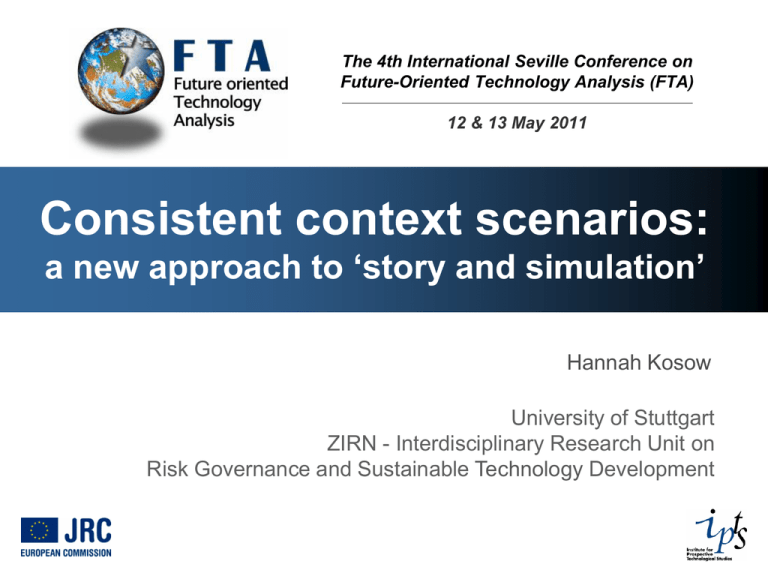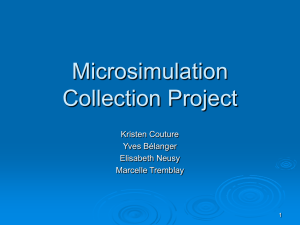Consistent context scenarios: a new approach to `story and simulation`
advertisement

The 4th International Seville Conference on Future-Oriented Technology Analysis (FTA) 12 & 13 May 2011 Consistent context scenarios: a new approach to ‘story and simulation’ Hannah Kosow University of Stuttgart ZIRN - Interdisciplinary Research Unit on Risk Governance and Sustainable Technology Development Consistent context scenarios: a new approach to ‘story and simulation’ Content I. Introduction II. SAS: story and simulation ideal type and practice strengths and weaknesses III.‘CIBAS‘: cross-impact balance analysis and simulation cross-impact balance analysis (CIB) conceptual ideas on CIBAS expected potential and limits IV. Conclusion 2 Consistent context scenarios: a new approach to ‘story and simulation’ Approaching futures of coupled humanenvironmental systems modeling and simulation systems analysis integrated modeling combining numerical modeling with qualitative scenario techniques (SAS) used for scientific exploration and to inform public and political debates but: usefulness and credibility of SAS scenarios for „producer-users“ and „recipient-users“ (e.g. Parson 2008, Pulver/ VanDeveer 2009) ? 3 Consistent context scenarios: a new approach to ‘story and simulation’ Focus Aims: to reflect current approaches and to discuss a new approach Question: (If and) how could CIB be used within a new approach to SAS and what potential benefits and limits can we expect from ‘CIBAS’ (i.e. CIB And Simulation)? Methods: literature review expert interviews conceptual ideas and expectations on potential and limits of ‘CIBAS‘ (empirical exploration and evaluation of CIBAS via case studies) 4 Consistent context scenarios: a new approach to ‘story and simulation’ ‘Story And Simulation‘ (SAS) (Alcamo 2001, 2008) Basic idea: to explore futures of coupled human-natural systems by combining numerical simulation models with qualitative storylines Central assumption: combination of ‘qualitative’ with ‘quantitative’ scenario approaches benefits from the advantages of both (Alcamo 2008: 124; Kemp-Benedict 2004:1; Winterscheid 2007: 54). 5 Consistent context scenarios: a new approach to story and simulation’ SAS: ideal type iterative process quantification story simulation (creative scenario technique) (numerical modeling) refinement product: qualitative and quantitative scenarios Source: own representation based on Alcamo 2001, 2008 6 Consistent context scenarios: a new approach to ‘story and simulation’ SAS: practice prototype studies Emission Scenarios (SRES) (IPCC 2000) Millennium Ecosystem Assessment (MA) (Carpenter et al. 2005) World Water Visions (Gallopin/ Rijsbersman 2000) Global Environmental Outlook GEO-4 (UNEP 2007) SAS covers a variety of designs combining numerical modeling with qualitative scenario techniques. 7 Consistent context scenarios: a new approach to ‘story and simulation’ SAS: strenghts use of scenario concept in its primary sense representation of uncertainty of social contexts integration of qualitative information inclusion of variety (of knowledge and of participants) possible 8 Consistent context scenarios: a new approach to ‘story and simulation’ SAS: weaknesses methodological imbalance: formal and systematic modeling vs. creative-narrative scenario technique ‘promise of consistency’ seems difficult to hold limited reproducibility ridden with prerequisites 9 Consistent context scenarios: a new approach to ‘story and simulation’ Cross-impact balance analysis (CIB) (Weimer-Jehle 2006) Example of a CIB matrix qualitative but systematic form of systems analysis based on expert judgments of interactions of system elements balance algorithm to determine consistent network configurations applied as qualitative scenario technique in various fields analysis via SzenarioWizard or with pen and paper www.cross-impact.de 10 Consistent context scenarios: a new approach to ‘story and simulation’ Some conceptual ideas on ‘CIBAS‘ ‘CIB instead or in addition to Intuitive Logics (IL)’ type ‘consistent context scenarios’ detail, nuance, creativity IL consistent context assumptions numerical modeling CIB precise, systematic & transparent approach simulation results product: qualitative and quantitative scenarios 11 Consistent context scenarios: a new approach to ‘‘story and simulation’ CIBAS: expected potential moderates the methodological imbalance of SAS by its systematic and semi-formalized approach assures the internal consistency of the qualitative scenarios via CIB supports the reproducibility of the scenario process (not of the result) by explicitly documenting underlying mental models including assumptions on interrelations 12 Consistent context scenarios: a new approach to ‘story and simulation’ CIBAS: expected limits is ridden with many of the same prerequisites as SAS, the translation of verbal into numerical statements remains a challenge, e.g. possibly tends to overemphasize causal relationships 13 Consistent context scenarios: a new approach to ‘story and simulation’ Conclusion CIBAS… could build on the strengths of SAS and balance some of its weaknesses might enhance the usefulness and the credibility of SAS processes Future work develop a conceptual framework on SAS processes and variants explore CIBAS empirically: two case studies have already started 14 Consistent context scenarios: a new approach to ‘story and simulation’ Ideas for further case studies are very welcome! Thank you hannah.kosow@sowi.uni-stuttgart.de www.zirn-info.de www.cross-impact.de 15





